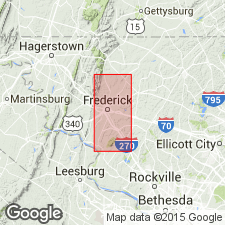
- Usage in publication:
-
- Lime Kiln Member
- Modifications:
-
- Named
- Biostratigraphic dating
- Dominant lithology:
-
- Limestone
- AAPG geologic province:
-
- Piedmont-Blue Ridge province
Summary:
Named as top member of Frederick Formation (revised). Named for Lime Kiln, Frederick Co., north-central MD. Consists of highly burrowed, very thin to thick limestone beds. Thickness at type is 180 m. Lower contact with Adamstown Member (new) is not often exposed, but shows transition from thinly bedded limestone of Adamstown to highly variable thick- to thin-bedded limestone of the Lime Kiln. Upper contact with Grove Formation is a sharp transition from medium or dark-gray, thinly to thickly bedded, mottled limestone to light-gray, highly quartzose, thickly bedded to massive limestone. Age is Late Cambrian based on fossils. Contains greater amounts of biogenic matter than lower members of Frederick. All fossils, including echinoderms, trilobites, brachiopods, and cephalopods, are Trempealeauan in age; specific zones such as SAUKIELLA JUNIA and SAUKIELLA SEROTINA subzones of SAUKIA zone of Great Basin can be recognized (M. Taylor, 1972, personal commun.). Report includes geologic map and sections, geologic columns, measured sections, correlation charts, and fossil lists.
Source: GNU records (USGS DDS-6; Reston GNULEX).
For more information, please contact Nancy Stamm, Geologic Names Committee Secretary.
Asterisk (*) indicates published by U.S. Geological Survey authors.
"No current usage" (†) implies that a name has been abandoned or has fallen into disuse. Former usage and, if known, replacement name given in parentheses ( ).
Slash (/) indicates name conflicts with nomenclatural guidelines (CSN, 1933; ACSN, 1961, 1970; NACSN, 1983, 2005, 2021). May be explained within brackets ([ ]).

